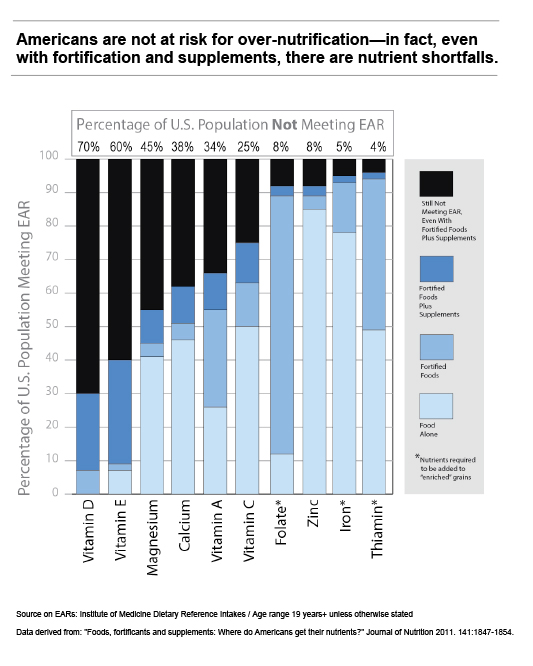Do Americans get all the nutrients they need from food alone? National nutrition surveys demonstrate that they don’t. Recent analysis of nutrient intakes of the U.S. population shows that a large percentage of people fall short of the average requirements of many nutrients. Almost everyone falls short of the average requirements for vitamin D and vitamin E, and more than one-third fall short of the average requirements for calcium, magnesium and vitamin A. Almost half fall short of vitamin C without fortification and supplement usage, even though it would be easy to get vitamin C from foods if they consumed even modest amounts of fruits and vegetables. Fortification of food helps, but many still miss their average requirements.
These data come from the National Health and Nutrition Examination Survey (NHANES) for 2003–2006, which collected detailed data on nutrient intakes of over 16,000 people of all ages (children and teens as well as adults). Results of the survey were published in 2011 in the Journal of Nutrition by four researchers who are experts in the analysis of nutrient survey data.1
The researchers looked at the nutrient intake data in three ways:
(1) the amount of each nutrient consumed from food alone, not including any nutrients added by enrichment or fortification and not including dietary supplements;
(2) the amount of each nutrient consumed from foods, including enrichment and fortification; and
(3) the amount of each nutrient consumed from all sources, including enrichment, fortification, and dietary supplements. Not everyone uses dietary supplements, so their ability to boost nutrient levels is limited to those who actually take them.
The researchers concluded: “Without enrichment and/or fortification and supplementation, many Americans did not achieve the recommended micronutrient intake levels set forth in the Dietary Reference Intakes.” As the table shows, nutrients supplied by enrichment, fortification, and supplementation help many people who would otherwise fall short.
researchers concluded: “Without enrichment and/or fortification and supplementation, many Americans did not achieve the recommended micronutrient intake levels set forth in the Dietary Reference Intakes.” As the table shows, nutrients supplied by enrichment, fortification, and supplementation help many people who would otherwise fall short.
What’s even more concerning from this research is that it compared actual nutrient intakes to the Estimated Average Requirements (EARs) for Americans as set by the Institute of Medicine (IoM), which establishes Dietary Reference Intakes for all nutrients. The EAR is the established level to provide the nutrient requirements for the midpoint of the population—just 50 percent. A population with intakes equal to the EAR means the nutrient requirements of half the population will be met, but the requirements of half the population will not; some people will need less, but half the population will need more. The further a population's average intake falls below the EAR, the greater the risk of inadequacy in the population.
The Recommended Dietary Allowance (RDA) is the intake level established to be adequate to maintain nutritional health in almost all of the population. By definition, it’s higher than the EAR because it is intended to be the target intake for individuals, not populations to assure you are getting adequate nutrients. But don’t worry: because of the wide range of safe vitamin and mineral intake levels, if you are one of the people who just doesn’t need as many nutrients (your personal requirements fall below the EAR), meeting the RDA won’t lead to health concerns even if you get a little more than you need.
1Data derived from "Foods, fortificants and supplements: Where do Americans get their nutrients?" Journal of Nutrition 2011. 141:1847-1854.
Authors: Victor L. Fulgoni, III. Nutrition Impact LLC, Battle Creek, MI
Debra R. Keast, Nutrition Database Research, Inc., Okemos, MI
Regan L. Bailey, Office of Dietary Supplements, NIH, Bethesda, MD
Johanna Dwyer, Jean Mayer USDA Human Nutrition Research Center on Aging, and Schools of Medicine and Friedman School of Nutrition Science and Policy, Tufts University, Boston, MA


